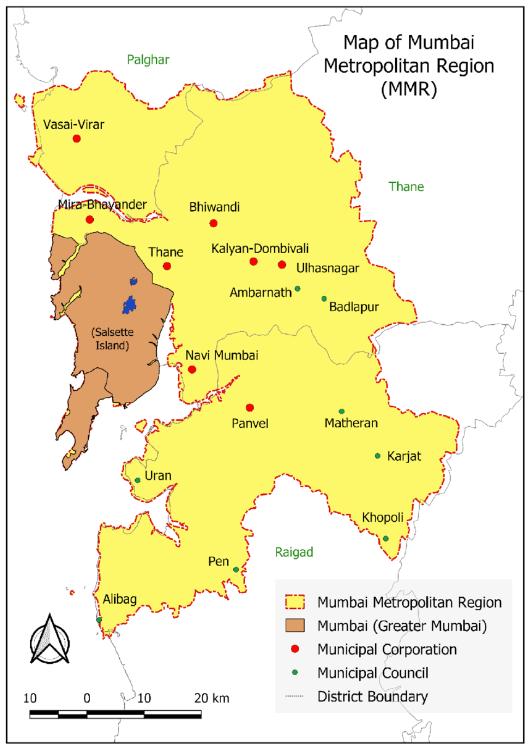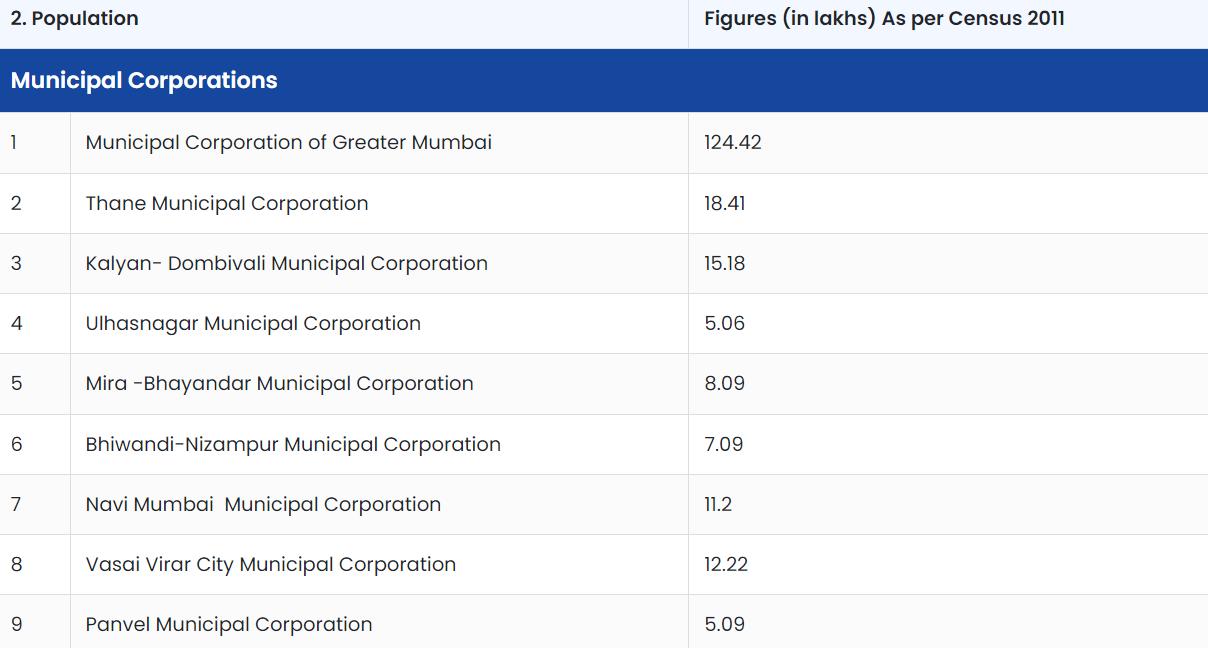



Table of Contents
- About Mumbai Metropolitan Region (MMR)
- Municipal Corporations under MMR
- Municipal Councils under MMR
- Maharashtra is divided into four districts
- Population and Demography of MMR
- About Mumbai Metropolitan Region Development Authority (MMRDA)
- Urban Development and Key industries
- Major Ports
- Cultural Heritage and Landmarks
- Faq's
The Mumbai Metropolitan Region (MMR) reflects the rapid urbanisation and economic development of Mumbai. This expansive area pulsates with life, diversity, and opportunity for the city and its surrounding satellite towns. Whether in the streets of Mumbai or the bustling neighborhoods of its neighboring cities, the MMR is a melting pot where cultures meet, businesses flourish, and dreams come true.
In this article, we will take a deeper look at the landscape of the Mumbai Metropolitan Region, and explore its rich cultural tapestry, booming economy, and the regions that make this sought-after locality in Mumbai. Join us through this journey of discovering the vibrant urban region in India to uncover what makes it a unique and compelling destination in India.
About Mumbai Metropolitan Region (MMR)

The MMR is home to over 23 million people, making it one of the most populous metropolitan and is spread over 6,328 sq. km. The region consists of 9 municipal corporations and 9 municipal councils along with more than 1,000 villages in Thane, Raigad and Palghar Districts. The Mumbai Metropolitan Region Development Authority (MMRDA) is responsible for the balanced development of the MMR.

Source: Official Website of MMRDA (https://mmrda.maharashtra.gov.in/)
Municipal Corporations under MMR
- Greater Mumbai
- Thane
- Kalyan-Dombivali
- Navi Mumbai
- Ulhasnagar
- Bhiwandi-Nizamapur
- Vasai-Virar
- Mira-Bhayandar
- Panvel
Municipal Councils under MMR
- Alibag
- Ambernath
- Karjat
- Khopoli
- Kulgaon Badlapur
- Matheran
- Panvel
- Pen
- Uran
Maharashtra is divided into four districts
- Mumbai City (complete)
- Mumbai Suburban (complete)
- Thane (partial)
- Raigad (partial)
Population and Demography of MMR
The Mumbai Metropolitan Region (MMR) is a diverse and densely populated area that encompasses Mumbai and its surrounding regions. With a population that includes a mix of urban, suburban, and rural areas, the demography of MMR reflects a blend of cultures, languages, and socio-economic backgrounds.
Mumbai, as the central hub of the region, is known for its cosmopolitan nature, attracting people from various parts of India and the world. The population of MMR is characterised by a high level of diversity, with a significant number of migrants seeking opportunities in sectors like finance, entertainment, and manufacturing.
The demographic landscape of MMR is dynamic, with a mix of traditional communities and modern urban lifestyles, making it a vibrant and bustling metropolitan area.

Source: Official Website of MMRDA (https://mmrda.maharashtra.gov.in/)
About Mumbai Metropolitan Region Development Authority (MMRDA)
The Mumbai Metropolitan Region Development Authority (MMRDA) was set up to execute the regional plan and oversee planning, development, and coordination within the MMR. The MMR, established in 1967, saw its first Regional Plan approved in 1973. Subsequently, MMRDA crafted a revised plan for 1996-2011, effective from December 1, 1999.
In 2009, the Mumbai Metropolitan Planning Committee (MMPC) was formed under the Mumbai Metropolitan Planning Committee Act, 1999. The MMPC guided MMRDA in revising the Regional Plan. After incorporating public feedback and committee recommendations, MMRDA submitted the modified plan to MMPC in October 2017. The MMPC approved it with changes and forwarded it to the Government of Maharashtra (GoM) for final sanction.
In August 2019, GoM sanctioned a portion of the plan related to the Matheran Eco-Sensitive Zone. Additionally, in September 2019, GoM expanded the MMR boundaries to include Palghar Taluka in the north and Khalapur, Pen, and Alibaug Talukas in the south, enlarging the total area to approximately 6,500 sq. km.
Also Read: Mumbai Stamp Duty, Registration Charges and Abhaya Yojana Scheme-2024
Urban Development and Key industries
The MMR has witnessed significant urban changes in recent years, impacting both the city and its peri-urban areas. The key industries in the Mumbai Metropolitan Region include gems & jewellery, leather processing, IT and ITES, textiles, petrochemical, electronics manufacturing, automobiles, and entertainment. These industries play a significant role in the economic growth and development of Mumbai, contributing to its status as a major financial and commercial hub in India.
Major Ports
The major ports in the Mumbai Metropolitan Region include Mumbai Port, Jawaharlal Nehru Port (JNP), and Dharamtar Port
Mumbai Port, established in 1873, is one of the premier ports in India located in Mumbai, Maharashtra, with significant facilities and a long history of service.
Jawaharlal Nehru Port, also known as JNPT or Nhava Sheva Port, is the second largest container port in India after Mundra Port, situated on the eastern shores of the Arabian Sea in Navi Mumbai, Raigad district.
Dharamtar Port is another significant port located in the Mumbai Metropolitan Area. These ports play a crucial role in the maritime activities and economic development of the region.
Also Read: MahaRERA: What Are The Functions And Duties Of A Promoter
Cultural Heritage and Landmarks
The region is steeped in history and boasts iconic landmarks that narrate its rich heritage.
Some of the key cultural heritages and landmarks in the MMR include:

Gateway of India: An iconic monument built in 1924 to commemorate the visit of King George V and Queen Mary to Mumbai. It is a beautiful structure made of yellow basalt located at the waterfront of the Arabian Sea
Chhatrapati Shivaji Terminus (CST): A UNESCO World Heritage Site, CST is a prime example of Victorian Gothic architecture and a significant train station in Mumbai, known for its intricate design and historical importance
Elephanta Caves: Another UNESCO World Heritage Site, these caves on an island in Mumbai harbor are dedicated to the worship of Shiva and feature impressive carvings, including a six-meter tall relief sculpture of a three-headed Shiva
Victorian Gothic and Art Deco Ensembles of Mumbai: This collection of 94 buildings from the 19th and early 20th centuries showcases the legacy of British colonial architecture in Mumbai, including notable structures like Bombay High Court, University of Mumbai, and Chhatrapati Shivaji Terminus
Mount Mary Church: A Roman Catholic Basilica in Bandra where the city converges for midnight mass on Christmas Eve, with a history dating back to the 17th century
Rajabai Clock Tower: Known as the Big Ben of Mumbai, this tower at the University of Mumbai is a blend of Venetian and Gothic styles with beautiful stained glass windows
Banganga Tank: An ancient water tank located at Malabar Hill with a legend tied to Hindu mythology, rebuilt over the years and surrounded by serene surroundings
As the MMR continues to evolve, there is a growing emphasis on sustainable development and urban planning. Efforts to address housing affordability, transportation efficiency, and environmental conservation are crucial for ensuring long-term viability of the region. Balancing economic growth with environmental sustainability remains a key focus for policymakers and urban planners.
In conclusion, the Mumbai Metropolitan Region showcases a blend of tradition and modernity, offering a glimpse into the vibrant urban landscape of our rich country. As the region navigates through urban challenges and opportunities, strategic planning and community engagement is going to further shape the growth trajectory.
explore further
Latest from Encyclopedia
More from Interactions
Resources
Dwello, for every home buyer, is a way to go from 'I feel' to 'I know', at no extra cost.




